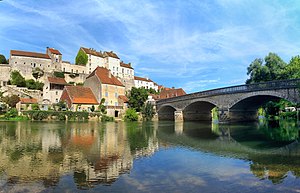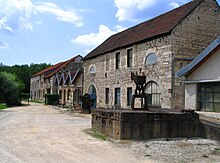Pesmes
| Pesmes | ||
|---|---|---|

|
|
|
| region | Bourgogne-Franche-Comté | |
| Department | Haute-Saône | |
| Arrondissement | Vesoul | |
| Canton | Marnay | |
| Community association | Val de Gray | |
| Coordinates | 47 ° 17 ' N , 5 ° 34' E | |
| height | 187-291 m | |
| surface | 18.64 km 2 | |
| Residents | 1,084 (January 1, 2017) | |
| Population density | 58 inhabitants / km 2 | |
| Post Code | 70140 | |
| INSEE code | 70408 | |
| Website | www.pesmes.fr | |
 Pesmes on the banks of the Ognon |
||
Pesmes [ pɛm ] is a municipality in the French department of Haute-Saône in the region Bourgogne Franche-Comté . It belongs to the canton of Marnay in the arrondissement of Vesoul and was the administrative seat of the communal association Communauté de communes du Val de Pesmes, which was dissolved in 2016 . Pesmes has been awarded the label of the most beautiful villages in France .
geography
Pesmes is located at an altitude of 200 m above sea level, about 38 kilometers west of the city of Besançon (as the crow flies). The municipality is located in the center of the city square Besançon, Dole , Dijon and Gray . The town extends in the extreme south of the department, slightly elevated above the northern bank of the Ognon , which emerges from the gently undulating landscape of the Franche-Comté into the Saône plain , north of the ridge of the Massif de la Serre .
The area of the 18.64 km² large municipal area includes a section of the lower Ognon Valley. The southern border mostly runs along the Ognon. This flows here with several turns to the northwest through an alluvial plain that is one to three kilometers wide and averages 190 m. It is mainly used for agriculture. The river splits into several branches and forms islands, for example the Île de la Sauvageonne near Pesmes. Some sections of the valley floor also belong to Pesmes south of the Ognon. From the course of the river, the municipal area extends northward over the valley level into the Les Chazeaux forest and north-east to the adjacent plateau. This is made up of tertiary sediments and extends to a height of 230 m. Agricultural use also predominates here. At 291 m, the highest point of Pesmes is reached on the ridge of the Bois du Gâtis on the eastern municipal boundary . With a narrow tip, the community soil extends north into the extensive forest area of the Gros Bois .
Pesmes neighboring municipalities are Broye-Aubigney-Montseugny , Sauvigney-lès-Pesmes , Chevigney and Valay in the north, La Résie-Saint-Martin , Chaumercenne and Bard-lès-Pesmes in the east, Malans and Dammartin-Marpain in the south and Mutigney in the west .
history
Numerous finds from Gallo-Roman times (ceramics, coins, wall foundations) indicate an early settlement of the area around Pesmes. The origins of the village of Pesmes are obscure. In the Middle Ages the place belonged to the Free County of Burgundy and in it to the area of the Bailliage d'Amont . The existence of the noble family de Pesmes , who acted as vassals of the Counts of Burgundy, has been documented since the 11th century . Under this family, Pesmes developed into a medieval town with a castle and fortifications at an important crossing over the Ognon. The male line of the noble family died out in 1327.
During the Hundred Years War Pesmes was affected several times, so in 1362 by the Routiers , 1364 by the Burgundians and in 1409 by the English and again by the Burgundians. In 1477 the town was set on fire by troops from the House of La Trémoille . The rule was then by the French King Louis XI. confiscated and given to a von Chavannes family. Around 120 houses were destroyed in a major fire in 1621. Together with the Franche-Comté , Pesmes finally came to France with the Peace of Nijmegen in 1678. The rule of Pesmes was made a marquisate in 1754 and shortly before its end in 1787 as part of the French Revolution, a duchy.
In 1660 Claude de La Baume laid the foundation stone for the iron works ( Forges de Pesmes ) on the Ognon below Pesmes , in which mainly weapons were manufactured. Towards the end of the 18th century the workshops were massively enlarged and two blast furnaces were added. The energy for the operation of the systems was provided by the hydropower of the river, which was dammed here with a weir . For a long time, the plants were of great economic importance to the region. Since Pesmes was not connected to the French railway network in the 19th century, the ironworks were at a disadvantage compared to the competition. The blast furnaces ceased operations in 1875. As a result, the plant specialized in the production of tools, mechanical engineering and the manufacture of car accessories. In 1992 production was completely stopped. Today Pesmes is the administrative seat of the community association Communauté de communes du Val de Pesmes, which comprises 18 villages .
Attractions
Pesmes has preserved the medieval townscape of a small town in Franche-Comté with a church and castle as well as numerous town houses from the 16th to 18th centuries. The Saint-Hilaire church originally dates from the 12th century and was remodeled in the late Gothic style in the early 17th century . It is richly decorated : an alabaster altar in the side chapel of the d'Andelot (15th century), which is decorated with marble in the Renaissance style, a marble statue of Mary (15th century) by Jean de La Huerta , a triptych (16th century) by Jacques Prévost , furniture, paneling and statues from the 16th to 18th centuries, a pulpit (16th century) by Claude Le Rupt and numerous tombstones. The former priory chapel has also been preserved. A stone cross from the 14th century stands in the cemetery; further stone crosses from this period can be found in the town.
Of the secular buildings, the castle is the first to be mentioned. It stands on a rocky ledge over the north bank of the Ognon. Its origins go back to the 10th century. Today's massive building mostly dates from the 16th and 18th centuries. The town also houses the Maison Royale (17th / 18th century), the Hôtel Châteaurouillaud (14th and 16th century) and the Maison Granvelle (16th century). Remnants of the medieval city fortifications, including the gates Saint-Hilaire and Loigerot, have also been preserved.
The late 17th century Château des Forges was the home of the ironworks owner. The iron works are a monument to the industrial age. They are owned by the municipality of Pesmes and house a museum.
population
| Population development | |
|---|---|
| year | Residents |
| 1962 | 854 |
| 1968 | 924 |
| 1975 | 934 |
| 1982 | 985 |
| 1990 | 1.006 |
| 1999 | 1,057 |
| 2007 | 1,113 |
With 1084 inhabitants (as of January 1, 2017) Pesmes is one of the smaller municipalities in the Haute-Saône department. Pesmes reached its peak in the middle of the 19th century with more than 1,800 inhabitants during the heyday of the ironworks. After the population had decreased significantly in the first half of the 20th century (in 1901 there were still 1,311 people counted), slow but continuous population growth has been recorded again since the beginning of the 1960s.
Personalities
- Alfred Beyl (1886–1977), cyclist
Economy and Infrastructure
Pesmes, which lies on the road from Dole to Gray, was early on a town characterized by trade and commerce and the processing of agricultural products in the area. Since the end of the 17th century, the Forges de Pesmes ensured an economic boom. Today Pesmes performs central functions for the surrounding area. There are various retail and service companies for daily needs. In the last few decades, smaller commercial and industrial zones have emerged on the outskirts. Companies from the construction, transport and precision engineering industries have settled here. Pesmes is the location of a college and a water sports center.
The village is well developed in terms of traffic. It is on the main D475 road from Dole to Gray. A bypass is in the planning phase. The closest connection to the A36 motorway is around 20 km away. There are other road connections with Vesoul , Marnay , Pontailler-sur-Saône and Broye.
literature
- Pesmes . In: Matthäus Merian : Topographia Circuli Burgundici ( Wikisource )
Web links
Individual evidence
- ↑ Prononciation in Forvo; Retrieved February 18, 2014
- ↑ Pesmes on Les plus Beaux Villages de France (French)


